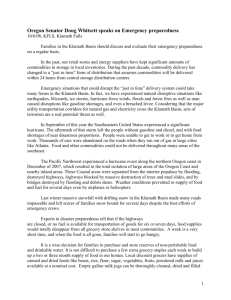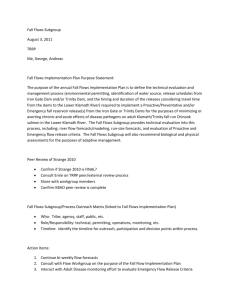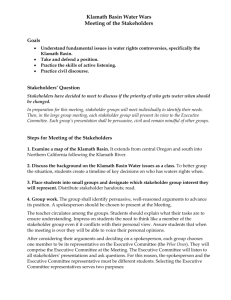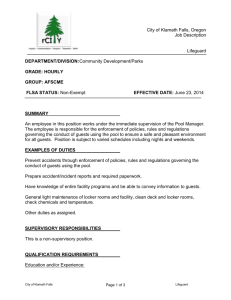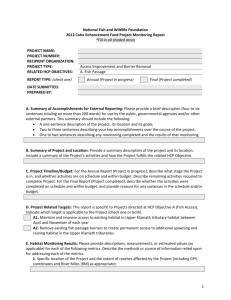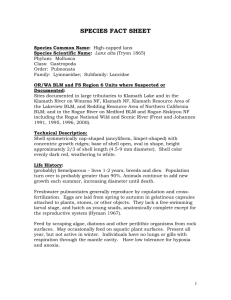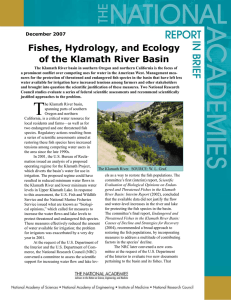Upper klamath lake - National Center for Case Study Teaching in
advertisement
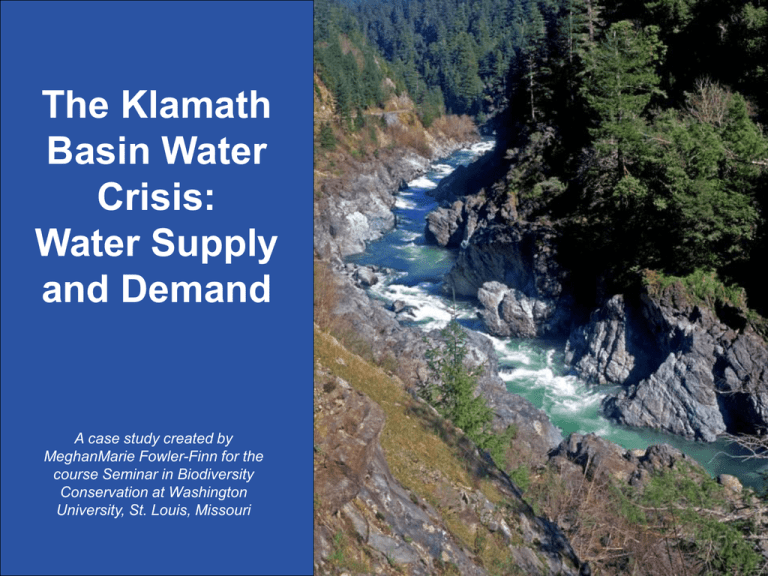
The Klamath Basin Water Crisis: Water Supply and Demand A case study created by MeghanMarie Fowler-Finn for the course Seminar in Biodiversity Conservation at Washington University, St. Louis, Missouri 1 Global Water Crisis • 1.1 billion people lack safe drinking water. • 66% of total withdrawal of fresh water is used for irrigation, followed by industry, domestic households, and evaporation. • Over 260 river basins are shared by two or more countries. • Aral Sea, in Central Asia, has lost half its superficies, or 2/3 of its volume, leaving 36,000km2 of land covered by salt. 2 3 4 Klamath Basin National Wildlife Refuges Issues: • Cropland rotation program • 80% of original wetlands lost • Water quality degraded; quantity decreased during drought • 80% of Pacific Flyway’s waterfowl supported by wetlands • Logging permitted to improve forest health by thinning Seasonal Migrations: Fall: waterfowl, peaks can reach 1 million birds Winter: bald eagles, largest concentration in contiguous U.S. Spring: waterfowl return, songbirds, shorebirds, one of the few remaining American white pelican breeding colonies Summer: waterfowl and marsh birds Significant Species: American bald eagle * Yellow rail Lost River sucker * Great gray owl Shortnose sucker * Sandhill crane Golden eagle Osprey American white pelican Rocky Mountain elk White Faced Ibis Spotted frog Peregrine falcon Wood duck Western & eared grebes Mule deer Wocus-yellow pond lily Pronghorn antelope Double-crested cormorant Tri-colored blackbird Black tern Great blue heron Northern goshawk Great egret, snowy egret Sage grouse Snow, Ross’, white-fronted, & Canada geese Pintail, mallard, gadwall, canvasback, redhead * Indicates endangered species 5 Upper Klamath Lake Marsh Drainage 1880s to the 1970s 6 7 8 The Worth and Cost of Agriculture • Potatoes, alfalfa, onions, sugar beets, barley, etc. • Losses of farm income worth $73-$92 million in 2001, when the federal government shut off irrigation because of a severe drought in 2000-2001. • Emergency payments by federal government covered $46 million of above losses. • 13% of jobs in this region are related to agriculture. • Irrigation from the Klamath River Basin accounts for half of the agricultural production in this area. • Agricultural runoff, especially in the fostering of algal blooms and depleted oxygen levels, is blamed for massive fish kills. • Cattle grazing on river basin land area depends on irrigation and can cause eutrophication and contamination through cow feces. 9 10 11 Loss of Fish • In 2002, when irrigation was allowed to resume, 3060 thousand fish died. • Flavobacterium columnare found on dead suckers. • Disease caused by increased water temperatures? • Salmon cannot swim up river and spawn because dams block the way. • Agriculture runoff pollutes the water and causes excessive algae blooms. 12 Temperature Changes Below the Iron Gate Dam on the Klamath River it was found that: • “cumulative exposures to stressful temperatures have been increasing in both number and duration” • “length of annual period of potentially stressful temperatures has been increasing” • “average length of river with suitable temperatures has been decreasing” 13 Native Americans • Return of C'waam Ceremony celebrates fish runs in March, which traditionally coincided with dwindling winter supplies of other food sources. • The Bureau of Reclamation signed a treaty in 1864 with the Klamath Native Americans that ensures the provision of Coho salmon and steelhead trout, two fish valuable to their traditions. • 1974, Federal Courts ruled that the Klamath retained Treaty Rights to hunt, fish, and gather in the Klamath Basin and should be consulted in land management decisions. • The Klamath are suing PacifiCorp for the dams that block the salmon run. 14 PacifiCorp's Side of the Story • Hydroelectric power is a clean way to fuel the area and removal of dams may increase pollution by increasing other means to generate power • In 2008 PacifiCorp came to an agreement in court as to their future involvement on the Klamath River. Several lower dams will be removed. However removal has not commenced because PacifiCorps refuses to do anything without guarantees from the government waiving responsibility from problems that may arise due to dam removal. See the following website for more information. http://www.klamathbasincrisis.org/Poweranddamstoc/nodams/toc.htm • Students can be asked to discuss whether fish ladders are worth considering if they cost more than the dams. 15 16 The Fish Industry • An entire fish industry is based on endangered Coho salmon and other fish that inhabit the Klamath River. • Hatchery fish constitute a large proportion of fish in Klamath River, but might endanger wild fish. • Fish spawn in Klamath Lake, but the majority are prevented from returning there by multiple dams. • Thousands of jobs depend on the harvesting of salmon and other fish. • Hatchery fish are considered in numbers for wild species endangered status. • Should Coho salmon still be considered endangered if hatchery fish push numbers past endangered status? 17 2006 Klamath Project Operations Plan • Abide by the NOAA Fisheries 2002 Biological Opinion and require water in the Klamath River and Upper Lake to be at adequate levels. • Reduce water from irrigators and National Wildlife Refuges when necessary in equally proportionate amounts according to area. • Draw from outside water when needed, although outside sources not yet determined. • Water in 2005 was plentiful enough for the Project, the Refuges, and the fish, but will it be plentiful enough for the long term? 18 Credits • • • • • • • • • Slide 1: Licensed photo ©iStockPhoto/Mike Norton. Slide 3: World Water Council. http://www.worldwatercouncil.org. Water GAP 2.0 December 1999. Used with permission. Slide 4: Map adapted from U.S. Department of Agriculture, Natural Resources Conservation Service. http://www.nrcs.usda.gov/feature/klamath/ Slide 6: “Nitrogen and Phosphorus Loading from Drained Wetlands Adjacent to Upper Klamath and Agency Lakes, Oregon,” 1997, Daniel T. Snyder and Jennifer L. Morace, U.S. Geological survey Water-Resources Investigations Report 97–4059. Slide 7: US Geological Survey. http://waterdata.usgs.gov/ca/nwis/uv?11516530 Slide 8: Photograph by Daniel T Snyder, U.S. Geological Survey. http://or.water.usgs.gov/pubs/Html/WSP2425/index.html Slide 10: Adams, Richard M. & Cho, Seong Hoon. "Agriculture and Endangered Species: An analysis of Trade-Offs in the Klamath Basin, Oregon." Water Resources Research. 34.10 (1998): 2741-2749. “Permission is granted ... to use figures, tables, and short quotes from the journal for republication in scientific books and journals.” (http://www.agu.org/pubs/copyright.html) Slide 11: “Photos taken on the Trinity River September 25. Some 10,500 salmon and steelhead were counted during overflight from Mill Creek on the Trinity River downstream to the Klamath boat ramp near Highway 101. Photo credit: Northcoast Environmental Center.” http://www.earthjustice.org/news/press/002/in_midst_of_salmon_kill_fishermen_dema nd_a_fair_share_of_the_water_and_challenge_long_term_plan_for_the_klamath_ba sin.html#photos Slide 16: Map from NOAA Fisheries. 19
